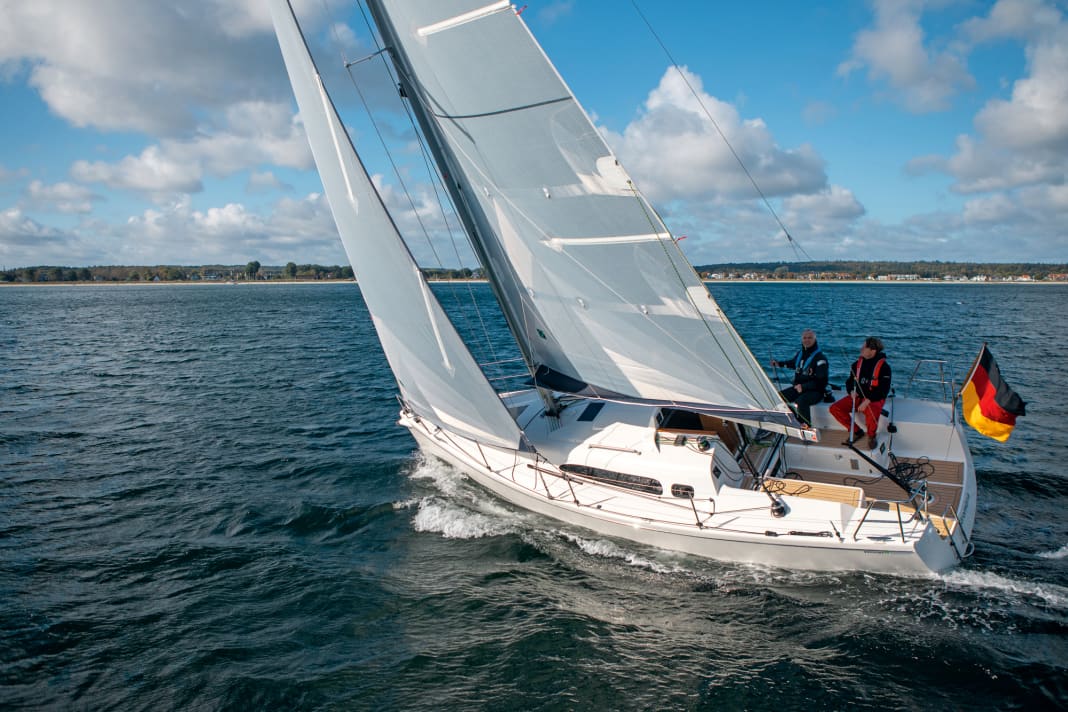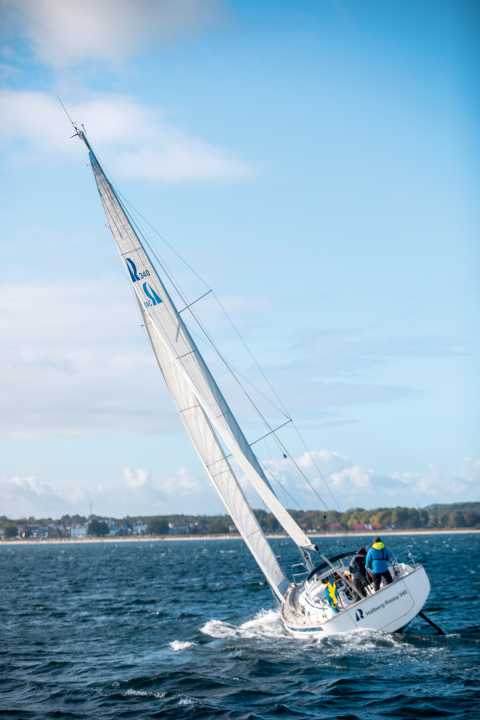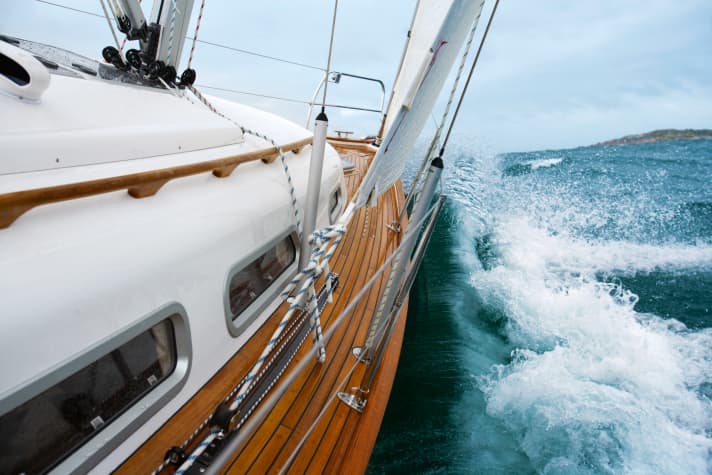


A day of sailing in strong winds can be difficult. Especially in spring, when the temperature differences between air and water are large, the potential for gusts is often high. Gusts that are twice as strong as the average wind speed are common. Recently, this phenomenon has increased, probably as a result of climate change.
What are gusts?
Gusts are brief gusts of wind whose speed is considerably higher than the mean wind speed. The German Weather Service defines them as having a minimum duration of three seconds and exceeding the mean wind speed by at least ten knots.
Gusts are caused by turbulent air currents, which can arise in different ways:
Dynamic turbulence
Land with hills or mountains upwind. As soon as the wind hits the ground and obstacles, it weakens and turbulence occurs - a kind of stop-and-go in the airflow, combined with rapid changes in direction.
Thermal turbulence
Large temperature differences between layers of air close to the ground or water and the higher atmosphere. If the temperature difference exceeds a certain level, the air stratification becomes unstable: the warmer air swirls upwards in updrafts, while cooler high-altitude air sinks downwards. This up and down in the air flow results in gusty winds.
Recognising gusts
- Clouds: White scattered clouds indicate a rather gusty day, a grey mass of clouds a rather stable one. However, it is difficult to tell exactly how gusty it will be
- Dark spots on the water and even whitecaps depending on the wind force
- Yachts and dinghies sailing ahead that suddenly lean heavily to one side
- Flags upwind, for example on fishing nets, which suddenly begin to flap strongly
Caution when a gust falls
Depending on the type of boat and the area, a gust of wind can have fatal consequences. Normally, a gust hits the boat a little rougher than the mean wind. However, this does not have to be the case. Depending on the weather conditions or spatial circumstances, such as proximity to land with high cover areas due to trees or buildings, a gust can also come in earlier until the sails fold over. The crew should therefore be prepared for anything.
The larger and stiffer the yacht, the higher its ballast ratio, the easier it generally copes with gusts. On more sporty boats, on the other hand, it can heel so quickly that it becomes dangerous. On the other hand, it is relatively unproblematic if the yacht is in open sea. Then the change in direction is usually not as strong as when close to land, and even an uncontrolled sun shot does not make too much difference. However, in narrow waterways, close to the shore or at a short distance from other yachts or buoys, a loss of control can be devastating.
This is another reason why every skipper should be aware of the prevailing conditions before leaving the harbour and prepare the yacht accordingly. This includes stowing equipment in case of heavy heeling as well as briefing the crew and securing them accordingly. Because gusts can come in very suddenly and very hard. Sometimes there is hardly any time to react. However, if the yacht then lays heavily on its side, this can come as a surprise to crew members. Equipment tumbling around is not exactly helpful in this case either. In principle, you have to be prepared for two wind systems, the medium wind range and the gust potential, and juggle between the two to decide which should ultimately be given more weight.
Adjust the trim to the gusts
This also applies to the yacht's basic trim when preparing for gusts. Normally, this should be optimised for the average wind speed. However, if the gusts are very strong, too much profile in the sails can quickly lead to the boat becoming uncontrollable. It is therefore better to trim the sails too flat at first, for a higher wind range than the average wind speed, or even reef them as a precaution. It is always better to reef or release the trim later than to get into a dangerous situation.
These trimming measures are available in gusts
Trimming the mainsail
The mainsail should be trimmed as flat as possible when the gust potential is high. Less profile means less pressure and less heeling when the wind picks up. The reefing point can also usually be moved significantly into a higher wind range. To do this, the main halyard should be maximised and, if available, the luff extrusion, also known as the cunningham. This shifts the sail profile towards the mast. The lower luff should also be fully feathered to flatten the lower sail area. The mast bends depending on the rig and the profile is trimmed flat. This also reduces the sag of the forestay.

Trim genoa
The same applies to the headsail as to the mainsail. Firstly, push through the halyard to flatten the profile towards the forestay. However, this also closes the leech, and the more stretched the aspect ratio of the luff and foot is, the more this happens - i.e. less with large genoas than with more modern, jib-like headsails. For this reason, it may also be right to ease the halyard slightly to open up the leech. You have to try it out. In any case, move the hoist point significantly aft. This increases the tension on the lower leech and flattens it, while reducing the tension on the leech so that it can open.

Reefing
This is the most effective way to reduce sail pressure. However, the reefed sail area is then missing between the gusts. The order in which the sail is reefed depends on the rig and the type of sail. As almost all furling genoas lose a large part of their profile and thus their function when reefed, the following fast rules apply. If the headsail can be changed, first hoist a smaller headsail, then reef the mainsail. With furling genoas, reef the main first, then the genoa to keep it in the best position for as long as possible. This can go so far that the main is already reefed twice and the genoa not at all. The same applies here: try it out.

Reaction options on the Amwind course
Even the best preparation will not relieve the crew of the task of having to react to strong gusts during the trip. We will show you here what reaction options are available. We will limit ourselves to the upwind course, as this is where gusts have the greatest effect. The following generally applies to deep courses such as reaching: drop with the gust, sail with it, and if possible do not luff, as this increases the risk of a sun shot. If the yacht becomes heavy or uncontrollable, it is essential to reef.
Anluven
This is the simplest reaction, but not necessarily the best. No sheets or anything else need to be operated, only the person at the helm is involved. Bringing the yacht a little higher upwind just before the gust arrives minimises the effect of the wind coming in a bit rougher in a gust. If the yacht is luffed even further so that the sails start to kill in the front third, even the increased heeling that would otherwise occur can be luffed away.

Traveller fieren
A traveller that is easy to reach, easy to run and as wide as possible is one of the best tools against incoming gusts. When the pressure builds, move the car boldly to leeward. The sail profile does not change, only the angle of attack of the mainsail to the wind. This can go so far that it kills the sail. This avoids heeling; after the gust, the traveller is relatively easy to tighten up again.

Fasten mainsheet
Depending on the strength of the gust, the mainsail operation can be a furling or a complete release of the mainsheet. This can have two effects: In conjunction with a strong, full boom vang, the furling has the same effect as with the traveller - a change in the angle of attack, not the profile. If the downhaul is loose, the boom rises with the furling and the profile of the mainsail opens aft, the sail twists more, turns up and releases the pressure. This can be particularly effective with so-called squarehead mainsails, i.e. those with a very wide sail head. However, it is usually a tedious task to tighten the sail after the gust, as not only does the boom have to be brought back to its optimum angle of attack, but it also has to be pulled downwards to increase the leech tension. This can be very strenuous.

Enforce backstay
An easily trimmable backstay is another way of reacting to gusts. It is used intensively on sports boats in particular. Trimming causes a stronger mast bend and a flatter mainsail, but above all less pressure on the leech and thus its twisting and blowing out. It releases the pressure. To achieve this, however, the stay must be ergonomic and easy to handle.

Further tips on gust handling
On an upwind course, it is less useful to steer out of gusts with a lot of lay than to steer the yacht upright through them with the sails open. In addition to the possible loss of control, a lot of layline often means a fear factor for inexperienced crew members. In addition, when steering out of a gust, the boat can hardly convert the stronger wind into additional speed in the usually short time it is in effect if it is not already sailing at hull speed. You are more likely to lose speed as the sails kill and the rudder brakes, as well as height due to greater drift caused by heeling. Therefore, sail as upright as possible while maintaining your course through gusts. However, this requires active handling of the mainsail. The genoa should hardly ever be unfurled. It is usually difficult to close out again.
Understanding gusts
Why heeling increases in the gust
A yacht sails with the apparent wind. An increase in the true wind, as in a gust, not only means an increase in the apparent wind, but also a change in its direction. In the diagram, the wind increases by five knots from the left-hand drawing to the right-hand one. If the speed of the yacht remains the same, the apparent wind also increases by five knots, but at the same time increases by seven degrees. This adds up to two heeling effects.

Why the yacht becomes greedy to windward
If a gust presses into the sails, the effect described on the left occurs. The pressure becomes too great and the yacht heels. If the sail pressure point (SDP) and lateral centre of gravity (LSP) were previously approximately in equilibrium, the sail pressure point shifts to leeward, further away from the boat, as the angle of lean increases. As the sails pull ahead but the hull brakes, the entire system is now levered around the lateral centre of gravity and the yacht becomes luffy to the point of losing control.


